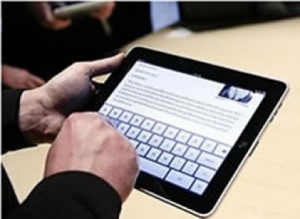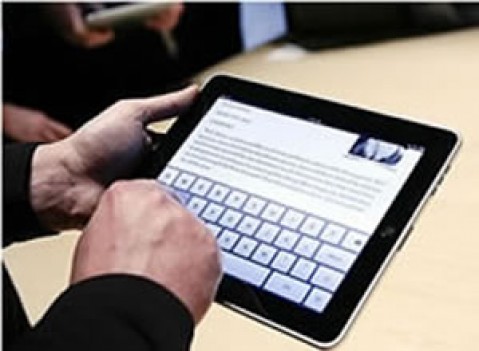Through our innovations using iPad Air tablets, students definitely have a bright future ahead of them
 Imagine a school where paper is a dying species. Imagine virtual science labs that are making experiments possible that were previously deemed too expensive. Imagine unlimited resources and information at every student’s fingertips.
Imagine a school where paper is a dying species. Imagine virtual science labs that are making experiments possible that were previously deemed too expensive. Imagine unlimited resources and information at every student’s fingertips.
This school exists, and it goes by the name of Immaculata-La Salle High School. Our private Catholic school, which serves more than 800 students as a member of the Archdiocese of Miami, is extending the possibilities of technology.
Many people think of iPads in education as devices that need to be locked down. But at Immaculata-La Salle, we’re doing things a bit differently.
As Immaculata-La Salle’s executive director for advancement and technology, I manage our school’s one-to-one iPad program. Our students have been successfully using iPads in the classroom for more than two and a half years.
Simplifying MDM enrollment and iPad deployment
Prior to switching to AirWatch® by VMware for mobile device management (MDM), we rolled out 800 iPad 3 tablets. The process was grueling. It took about 16 hours to do the original 800 devices, but that was just pre-configuration! Our team still had to physically touch each device to distribute and enroll them. It took two days to distribute devices and two days to enroll them, followed by manual profile adjustments for each device. Overall, it took a full month to actually get everything set up the first time around.
I knew something had to change.
(Next page: A much better method of iPad Air tablet deployment)
In late 2013, I heard rumblings of the Device Enrollment Program (DEP) from Apple, a new way to quickly enroll and supervise Apple devices over-the-air (OTA). DEP was officially released in early 2014, and we were ready to collect, distribute, and enroll 600 iPad Air tablets to replace the majority of our existing fleet.
This time, the process would be simpler. It had to be, as we were working with a very tight timeframe. We only had half a day to perform the rollout. Although my team was a bit skeptical about meeting this deadline, we actually ended up finishing with time to spare. Miraculously, our second iPad rollout took just two and a half hours to complete! With these enrollment improvements, it’s much easier to get iPads out the door and get the users configured with all the resources they need.
Prior to rollout, we tested the workflow on a small group of senior students. I used them as test subjects and kept fine-tuning the instructions over time until it became very clear what they needed to do. The process was completely refined by the end of it.
As an Apple Distinguished Educator, I often consult with other schools looking to deploy iPads to their students. I’ll tell schools to try out new things, as there isn’t a one-size-fits-all deployment workflow. I advise them to test workflows, pick one that works, and go for it. This is how I found out what worked best for us.
Enabling teachers and students
The time saved during enrollment gives us a better chance to interact with students and teach them valuable lessons about technology. I like to remind students that the iPad requires a certain level of responsibility. I tell them that respecting these tools and using them correctly is the best way to get the most out of their devices. I always say, “Use them for the powers of good instead of evil.” With this idea, our students have fully embraced the iPads and have taken charge of keeping them secure.
Before we began iPad deployment in our school, some teachers had reservations. They were worried about having to change their lesson plans to adapt to this new technology. Fortunately, after implementation, teachers were pleasantly surprised to find out that the iPad didn’t require curriculum alterations. Instead, the iPads allow them to enrich and enhance certain parts of their lesson plans. And that’s what they liked the most—the easy adoption of iPads within their current lesson structure. It was a natural fit.
Though our school has never blocked functions like iMessage or the device’s camera, students still have some restrictions. When a student downloads an app that is on our blacklist, AirWatch sends the student a warning that tells them which app is in violation, and then asks the student to remove it within a certain time frame. The next policy is to have the device check in to our backend systems after the time expires.
At that point, if they still have the app on the device, AirWatch sends an email to our detention email address. By not following our school blacklist policy, students can actually receive detention for blacklisted apps! The AirWatch Compliance Engine is set up to take automated actions, too, which vary based on the severity of the incident. This automation has freed up much of my time as an administrator, allowing me to focus on other duties for the school.
Most importantly, our school’s iPad program is one of inclusion, one where everyone has a stake in the responsibility of these devices. We even have our own tech squad of students who act as level-one tech support. Watching students help each other with support issues is a rewarding experience for my team and me.
The results
Overall, teachers have seen a tremendous increase in productivity with AirWatch-managed iPads in the classroom. Students also have seen gains, as they use iCloud to back up their work and continue working on assignments from desktops stationed around campus. Moreover, we have completely streamlined the turnaround time for assignments and feedback to students through the introduction of this technology. The shortened feedback loop is critical when students are working on larger projects. If we wait two or three days to give the student feedback, they get stuck waiting. These iPads have changed all of this.
Students are also using the devices to learn outside the classroom. We have marine biology and environmental science programs in which students use iPads to do a lot on their marine excursions. We also have mangrove trees on campus, and students will do labs outdoors on campus by categorizing the leaves and studying the ecosystem with their iPads.
It is amazing to see how our curriculum has been enhanced by these devices. Through our innovations, students definitely have a bright and sunny future ahead of them!
Fredy Padovan is an award-winning education technology director and technology integration coach/presenter from Key Biscayne, Fla. He earned a master’s degree in education from Belmont University and a graduate certificate in education technology from Michigan State University.
- 4 ways to encourage play in education - April 25, 2024
- CoSN IT Leader Spotlight: Lisa Higgins - April 25, 2024
- It’s time to pay student teachers - April 25, 2024


Comments are closed.